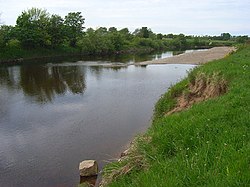Battle of Solway Moss
| Battle of Solway Moss | |||||||
|---|---|---|---|---|---|---|---|
| Part of Anglo-Scottish Wars | |||||||
 River Esk at Arthuret; a Scottish army was trapped nearby in 1542 |
|||||||
|
|||||||
| Belligerents | |||||||
|
|
|
||||||
| Commanders and leaders | |||||||
| Robert, Lord Maxwell, Sir Oliver Sinclair (POW) |
Thomas, Lord Wharton, Sir William Musgrave, John Musgrave |
||||||
| Strength | |||||||
| 15,000 – 18,000 | 3,000 | ||||||
| Casualties and losses | |||||||
| c. 20 killed; c. 1,200 prisoners; hundreds drowned |
c. 7 killed | ||||||
Coordinates: 55°00′40″N 3°01′33″W / 55.011225°N 3.025749°W
The Battle of Solway Moss took place on Solway Moss near the River Esk on the English side of the Anglo-Scottish border in November 1542 between English and Scottish forces.
The Scottish King James V had refused to break from the Roman Catholic church, as urged by his uncle King Henry VIII, who then launched a major raid into south west Scotland. The Scottish army that marched against them was poorly led and organised, and many Scots were either captured or drowned in the river. News of the defeat is believed to have hastened the early death of James V.
When Henry VIII of England broke from the Roman Catholic Church, he asked James V of Scotland, his nephew, to do the same. James ignored his uncle's request and further insulted him by refusing to meet with Henry at York. Furious, Henry VIII sent troops against Scotland. In retaliation for the massive English raid into Scotland, James responded by assigning Robert, Lord Maxwell, the Scottish Warden of West March, the task of raising an army.
...
Wikipedia
